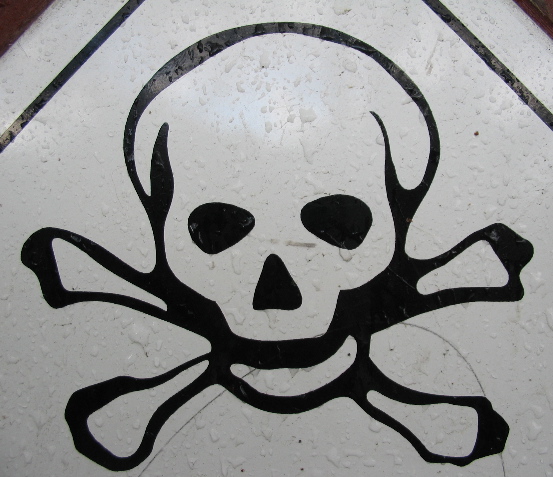Like this article? Chip in to keep stories like these coming.
![]()
The worst thing about Sarnia is that it’s beautiful.
Located on the shores of a river, a bay, and a Great Lake, Sarnia is a gorgeous little city. The waters are a deep, dark blue, and the parks are expansive and green. The streets are wide and clean, and it’s the kind of place where children still play outside until sunset. Many people have heard of Sarnia because they’ve crossed the Bluewater Bridges that connect Ontario to Michigan.
But now, due to the efforts of the Aamijiwnaang community’s Toxic Tour 2015, Sarnia is about to become a lot more famous.
This weekend on Sept. 4 and Sept. 5, busloads of people from London, Kitchener-Waterloo, Guelph, Hamilton, Toronto, Ottawa, and Montreal will be meeting the Aamjiwnaang youth to tour what we call the “Chemical Valley.”
This is a place where the major chemical plants are located. This is where plastic is made. This is where the chemicals for your pharmaceuticals are made. For anyone living in modern-day society, this is where Ontario processes the raw materials for the thousands of things that you use every day.
In Sarnia, almost everyone has a family member who works in the Chemical Valley. Every morning, the workers drive just outside of the city to these huge smokestacks that spew out fluffy clouds. At nighttime, it actually looks pretty, with all of the glittering lights making neon reflections on the sky. Parents who have never even been to Nevada will swear that it looks just like Las Vegas, and the children will happily believe them.
As a child, you would never, ever think of criticizing the Chemical Valley.
But when you move away as an adult, you think of your childhood and you begin to remember the little things. You remember air sirens going off because of a chemical spill, and having to close all of the windows and stay in your basement until it was safe to come out. During those times, you just watched a movie with your family, so it was no big deal that the sky was green and reeked like rotten eggs. The sulphur smell would clear up in a few hours, and when the radio announcers said it was okay to come out, you would play outside again.
If the spill happened during the school day, there would be an indoor recess. That was no big deal either, because the teacher would let you eat your snacks at your desk and wander around the halls. She would pull the curtains shut until later that day, when the principal would announce that there was an outdoor recess again, and everyone would cheer — even though the option of running around outside meant that many of you had to use a puffer for your asthma.
When you grow older, you realize how much cancer has touched the lives of your childhood friends. Part of your brain says, “Cancer affects almost every family nowadays; this is a statistic worldwide!” But then, the other part of your brain nags at you, bringing up pictures of your old buddies, and you realize that today, almost all of them have had a parent who was diagnosed with cancer.
Now that you live away from Sarnia, when you ask your new friends about this, they’re horrified. Almost none of their parents are dead, in chemotherapy, or have even had a mastectomy. Your heart starts to sink.
Some scientific studies have suggested that Asian immigrant women are the most susceptible to certain types of cancer. You’ve never considered this until you realize that almost half of the Filipino women you grew up with are dead. They babysat you, they attended your childhood birthday parties, they taught you traditional Philippine dance, they dropped by your house for spur-of-the-moment visits. These women didn’t even work in the Chemical Valley. But now, they’re gone.
When you live in Sarnia, you don’t want to believe that there is something coming from the Chemical Valley that could harm the people you love. Something in the air. Something in the soil. Something in the water. You don’t want to believe it, because for you, this is home.
This weekend, the Aamjiwnaang are bringing busloads of people on the Toxic Tour of the Chemical Valley. This is a community whose lives have been touched by the chemical refineries more than anyone.
They can’t hunt, they can’t fish, and because their reserve is beside the cloud-spewing smokestacks, they are the first ones to get sick from a chemical spill in the air — and they are often the first ones to report it.
Scientists even found that because of the chemicals coursing through their bodies, their women are the first in the world to give birth to two girls to every boy.
Sarnia is beautiful. Lake Huron is blue; Canatara Park is green. The streets are clean, and the children play outside until the sun sets. But why is this the worst thing?
Because if the waters turned black, and the parks turned grey, and the streets were filthy, then maybe, just maybe, Sarnians would see the truth. Maybe they would admit that the Aamijiwnaang aren’t “overreacting.”
Maybe things would truly start to change, and maybe, just maybe, Sarnia could become a healthier place for everyone.
Jennilee Austria was born and raised in Sarnia, and lived in Quebec, the Pacific Northwest, and The Netherlands before settling in Toronto. She is a writer, public speaker, and mentor, and has worked in social services for eight years.
Photo: flickr/ Greg Scales




